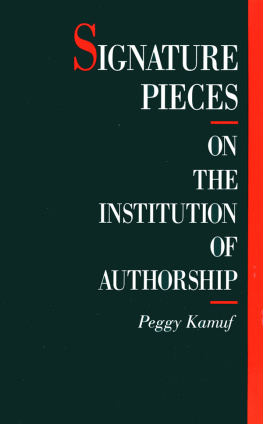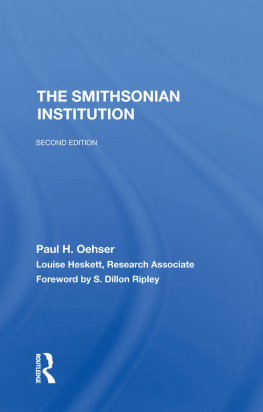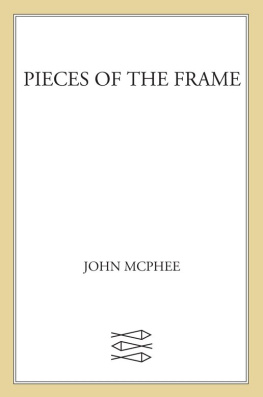Kamuf - Signature pieces: on the institution of autorship
Here you can read online Kamuf - Signature pieces: on the institution of autorship full text of the book (entire story) in english for free. Download pdf and epub, get meaning, cover and reviews about this ebook. City: London;Ithaca, year: 1988;2018, publisher: Cornell University Press, genre: Detective and thriller. Description of the work, (preface) as well as reviews are available. Best literature library LitArk.com created for fans of good reading and offers a wide selection of genres:
Romance novel
Science fiction
Adventure
Detective
Science
History
Home and family
Prose
Art
Politics
Computer
Non-fiction
Religion
Business
Children
Humor
Choose a favorite category and find really read worthwhile books. Enjoy immersion in the world of imagination, feel the emotions of the characters or learn something new for yourself, make an fascinating discovery.
- Book:Signature pieces: on the institution of autorship
- Author:
- Publisher:Cornell University Press
- Genre:
- Year:1988;2018
- City:London;Ithaca
- Rating:3 / 5
- Favourites:Add to favourites
- Your mark:
- 60
- 1
- 2
- 3
- 4
- 5
Signature pieces: on the institution of autorship: summary, description and annotation
We offer to read an annotation, description, summary or preface (depends on what the author of the book "Signature pieces: on the institution of autorship" wrote himself). If you haven't found the necessary information about the book — write in the comments, we will try to find it.
Kamuf: author's other books
Who wrote Signature pieces: on the institution of autorship? Find out the surname, the name of the author of the book and a list of all author's works by series.
Signature pieces: on the institution of autorship — read online for free the complete book (whole text) full work
Below is the text of the book, divided by pages. System saving the place of the last page read, allows you to conveniently read the book "Signature pieces: on the institution of autorship" online for free, without having to search again every time where you left off. Put a bookmark, and you can go to the page where you finished reading at any time.
Font size:
Interval:
Bookmark:

Im Nobody! Who are you?
Are youNobodytoo?
Then theres a pair of us!
Dont tell! theyd banish usyou know!
How drearyto beSomebody!
How publiclike a Frog
To tell your namethe livelong June
To an admiring Bog!
Emily Dickinson
(Anyway Ive had now to sing glad pleas for happy glad-dings of more endless pops & goes. I have signed my name but now I feel awfully frightened. Am I saying wisely in these solemn legalnesses) that any little murder, caused by here & there, has been quite let off by my names having been signed so beautifully!??
Stevie Smith
Like most books, this one began before it began. Its several preoccupationssignature, authorship, the gender of the writer or writinghad been dogging me for a long time. In particular, I was pursued by a persistent dissatisfaction with the way in which these terms tended to get confused or even collapsed into one another by most discourse concerned with the relation between writer and writing, and especially between the woman writer and her writing. That relation continued to be thought largely according to notions of representation, expression, the fully present intentionality of a subject, and so forth. I had been convinced for some time by demonstrations, most notably in the writings of Jacques Derrida, that such notions contributed essential elements to the metaphysical construction of womens exclusion, to the phallocentrism at the base of virtually all Western habits of thought. I was also convinced, therefore, that deconstructing this exclusion could not be a matter only of enlarging the field of expression to include feminine subjects, or writers, or writings. Unless this expansion is accompanied by a rethinking of some fundamental categories that have classified us as subjects, however discerning or changed the aspects of that subjectivity may appear, then the chances for displacement of the fundamental structures of exclusion are no doubt considerably lessened. Such rethinking, or rather thinking-beyond-the-subject, has been going on for some time now in many quarters and in many modes. This book merely gathers some of my own (halting and insufficient) attempts to give it its chance.
That these attempts or essays have come together under the single or singular title of signature may seem somewhat arbitrary at first glance. But, I would argue, it is the place of the signature that has been largely ignored, elided, or simply filled in by the presuppositions shaping much past and present discourse about the writer in/and his/her writing. The principal reason for this neglect is that this place is not a place at all, but an always divisible limit within the difference between writer and work, life and letters. Signature articulates the one with the other, the one in the other: it both divides and joins. It is this double-jointedness of signatures that will be lost to any discourse that continues to posit an essential exteriority of subjects to the texts they sign.
If we ask: What happens when someone writes his or her name in the mode of a signature? we may begin to see that this everyday occurrence is supported by immense conventional systems that tend to hide the precariousness of a general understanding of that act. For the most part, these conventions allow us to perform, in a more or less reliable manner, operations of identification, attestation, verification, attribution of responsibility, and so forth. Indeed, many social institutions thoroughly depend, in one way or another, on the reliable functioning of signatures, and whole areas of law can be said to be concerned almost exclusively with the rights and duties guaranteed by signatures (e.g., contract, property, and copyright law). The legal signature signals that, usually on a certain date and according to certain formalities, the subject named was present and assented to, accepted, affirmed some accord with another party. The subject named is thus first of all assumed to be present to himself or herself for the accord to have taken place between the identifiable parties to it. This accord presumes, moreover, that the signature represents a particular person, the bearer of a certain proper name and no other. It presumes, in other words, the possibility of singling out one subject from all others. But since names circulate within the public domain of language, they can always be changed or borrowed or duplicated. Supplementary guarantees of the singularity of signature must therefore be given, such as the notion of the verifiable differentiation of its mark. When you sign, you do not merely write your name, which anyone could do in your place: you affix your name as a particular mark. The singularity of the autograph, however, cannot be absolute; on the contrary, verifiability or authentication relies on its reproducibility by the subject named. If every time you sign your name, you deliberately make a significantly different mark, if no two of your signature acts resemble each other, then there is no telling after you have signed whether it was indeed you who signed. After a while, even you may forget having made some particular mark. Here the grounding assumption is that the subject named is not only self-identical with itself in the moment of signing but as well remains recognizably the same over time. By a seeming paradox, then, the singularity of the signatures mark depends on its limitation within recognizable parameters of reproducibility or iterability, which is to say of generalizability. The signature, therefore, is always detachable from the singular instance it supposedly designates. It can always be and in fact already has been detached from the signatory and expropriated by a field of general substitution. This is to remark that, within such a field of general substitution and exchange, the subject named is always finally a general subject, classified in a large but nevertheless limited number of ways. The particularization of this general subject through the functioning of signature is thus also always countersigned by the system of interchangeable likenesses, the system of the same in which singularity is but a necessary concept.
There are also, however, occasions when this conventional understanding is loosened and we are allowed to see the signature operating on its own, so to speak, as a particular use of the proper name. Such occasions are written works (literature in the general sense) bearing an authors signature which also make bare its uncertain operation. Yet the modern study of literature has largely contrived to look away from this exposed condition of the signature. To do so, it has dressed the signature in various guises: psychological, historical, formal, ideological. Working together, these constructs have produced what may be called the institution of authorship, an institution that masks or recuperates the disruptive implications of literary signature. Our investment in this institution is massive. All sorts of values are exchanged within its construction. There are enormous profits to be had, of course, and questions of what returns to whom, who gets what return, and who has rights over whatall these basically economic questions agitate the scene of the signature but also inscribe its unsettling otherness within an economy of the same. It is finally to this economy that the greater profits return; anyone can hold shares in it for the price of identification with authors via their written representatives, foremost and most essential among which is the signature.
By shifting some of the accumulated weight of authorship on the way we read and the way we act on what we read, this book attempts to recover some of the pieces that have fallen into the cracks of the identificatory economy. Three leverage points are used: the example of Rousseaus signature as a particularly lucid experience of dissociation between author and text; the signatures of Baudelaire and Woolf as demonstrations of how a signatures gender can also be interrupted; finally, two moments in a recent (but also long-running) theoretical debate over authorship, intentionality, and reading by identification. The first part is to be read as chapters in what I initially call a history of Rousseaus signature; the second and third parts each pair two essays with results that I hope are illuminating for both even though they may be read separately.
Next pageFont size:
Interval:
Bookmark:
Similar books «Signature pieces: on the institution of autorship»
Look at similar books to Signature pieces: on the institution of autorship. We have selected literature similar in name and meaning in the hope of providing readers with more options to find new, interesting, not yet read works.
Discussion, reviews of the book Signature pieces: on the institution of autorship and just readers' own opinions. Leave your comments, write what you think about the work, its meaning or the main characters. Specify what exactly you liked and what you didn't like, and why you think so.











